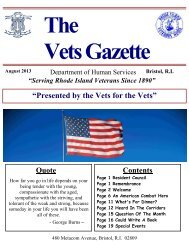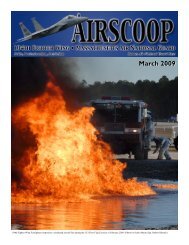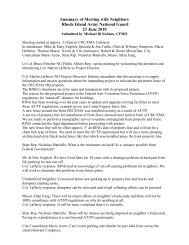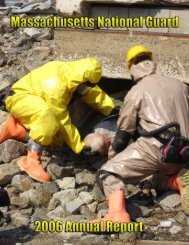Appendix K - Tungsten Information - STATES
Appendix K - Tungsten Information - STATES
Appendix K - Tungsten Information - STATES
Create successful ePaper yourself
Turn your PDF publications into a flip-book with our unique Google optimized e-Paper software.
NOIJ..VWHO.!lNI N:ilJ..S~Ni1J..<br />
:)1 XI
---<br />
Fate and Transport of <strong>Tungsten</strong> at Camp Edwards<br />
Small Arms Ranges<br />
~<br />
~~<br />
e ............<br />
JAY CLAUSEN, SUSAN TAYLOR, STEVEN LARSON, ANTHONY BEDNAR, MICHAEL<br />
KETTERER, CHRIS GRIGGS, DENNIS LAMBERT, ALAN HEWITT, CHARLES<br />
RAMSEY, SUSAN BIGL, RONALD BAILEY, and NANCY PERRON<br />
'!><br />
.' I>-L"<br />
-~<br />
... I'<br />
11:I<br />
,'-"<br />
.-<br />
.<br />
,<br />
J<br />
. \:.r:. .:~~L,~:or:::~~~:t": ,. !.\ .<br />
'...~. ..' ' ~~"J.i.,1... ~<br />
r<br />
I<br />
~ .I~..,~_. :t '. (if~, ., .<br />
March 2007<br />
. 3Ti?' t.<br />
,~<br />
:~ ? ~<br />
:~~..' ": ::: ..,; .' .-.;. .~'';' .:.-~. '« 'j ~-"<br />
~ ~' :"J... "11# '.'~ }:.., ? ~""-~~ ;J.. "<br />
~ :- , . ,. ':.c<br />
~ " .".' ,.. . . ~. :",.-.<br />
,.~ ~<br />
.,. .. i'~' "':'''<br />
' :1.,. "<br />
.<br />
. ';
ERDC/CRREL TR-07-XX<br />
March 2007<br />
Fate and Transport of <strong>Tungsten</strong> at Camp Edwards Small Arms<br />
Ranges<br />
JAY CLAUSEN1, SUSAN TAYLORI, STEVEN LARSON2, ANTHONY BEDNAR2,<br />
MICHAEL KETTERER3, CHRIS GRIGGS2, DENNIS LAMBERTI, ALAN HEWITTI,<br />
CHARLES RAMSEy4, SUSAN BIGL1, RONALD BAILEy1, and NANCY PERRON1<br />
1Engineer Research and Development Center<br />
Cold Regions Research and Engineering Laboratory<br />
72 Lyme Road<br />
Hanover, New Hampshire 03755<br />
2Engineer Research and Development Center<br />
Environmental Laboratory<br />
3909 Halls Ferry Road<br />
Vicksburg, Mississippi 39180-6199<br />
3Northern Arizona University<br />
3828 North Steves Boulevard<br />
Flagstaff, Arizona 86004<br />
4Envirostat Inc.<br />
P. O. Box 636<br />
Fort Collins, Colorado 80522<br />
Approved for public release; distribution is unlimited.
ABSTRACT<br />
Camp Edwards, Massachusetts, is the first of three military installations studied to assess the<br />
distribution of tungsten at small arms ranges. This study focused on three ranges at Camp<br />
Edwards: Bravo, Charlie, and India. <strong>Tungsten</strong> was present in surface soils up to 2,080 mg/kg.<br />
The highest observed concentrations of tungsten occur in bullet pockets and soil eroded from<br />
the berm face. <strong>Tungsten</strong> concentrations decreased in surface soils away from the berm in the<br />
following order: berm face, trough, target, range floor, and firing point. The concentration of<br />
tungsten in surface soils at the firing point is similar to background levels; i.e., 1.5 mg/kg.<br />
<strong>Tungsten</strong> levels in subsurface soils decreased with depth with an order of magnitude or more<br />
decrease in concentration within the top 25 em. However, samples collected at 150 em still had<br />
tungsten levels above background. Tension Iysimeters, installed into the primary berm face and<br />
the trough area, had dissolved tungsten up to 400 mg/L. The 24 Iysimeters did not exhibit<br />
consistent tungsten concentration trends and no trend was evident with depth. However, the<br />
concentration levels on the range were significantly elevated as compared to background. The<br />
mean tungsten concentration for Iysimeters installed in background locations is 0.09 mg/L and<br />
ranged between 0.011 to 0.169 mg/L. One out of three monitoring wells sampled had tungsten.<br />
Concentrations varied from 0.0044 to 0.56 mg/L in a monitoring well screened at the water<br />
table, approximately 37 m below ground surface, and located 10m downgradient of the Bravo<br />
Range primary berm face. A monitoring well located between Bravo and Charlie Ranges and<br />
several hundred meters downgradient had no reportable tungsten nor did two background wells.
iii ERDC/CRREL TR-07 -xx<br />
TABLE OF CONTENTS<br />
INTRODUCTION 1<br />
BACKGROUN D 2<br />
TUNGSTEN 2<br />
TUNGSTEN PROJECTILE 2<br />
CAMP EDWARDS 4<br />
OBJECTIVES.. 5<br />
CONCEPTUAL MODEL 6<br />
METHODS 9<br />
FIELD... 9<br />
Site Selection 9<br />
Sample Collection 13<br />
Surface Soil 15<br />
SubsurfaceSoil 18<br />
Backgroundsamples 18<br />
Water 18<br />
Sample Preparation 19<br />
_Soil...... ... ... ... ... 19<br />
Water... ... ... 19<br />
SAMPLE ANALySiS 20<br />
SoiL.. ... 20<br />
Water 20<br />
Other Methods 21<br />
QUALITY ASSURANCE/QUALITY CONTROL 23<br />
STANDARDS 23<br />
Soil 23<br />
Water... 23<br />
RESULTS 30<br />
FIELD MEASUREMENTS 30<br />
Soil 30<br />
Bravo (B) Range 30<br />
Charlie (C) Range 31<br />
India (I) Range 31<br />
Background 39<br />
Water... 39<br />
Soil Pore-Water (Lysimeters) 39<br />
Groundwater 42<br />
Background 44<br />
LABORATORY TESTS 48<br />
DigestionTechniques 48<br />
Characteristicsof <strong>Tungsten</strong>and Camp Edwards Soil 48<br />
X-Ray Diffraction 48<br />
Scanning ElectronMicroscope 48
iv ERDC/CRRELTR-07-XX<br />
Solubility Tests 48<br />
Batch tests 48<br />
Dissolution Experiments 49<br />
DISCUSSION ...51<br />
DISTRIBUTIONOF TUNGSTEN 51<br />
FATEANDTRANSPORTOF TUNGSTEN 53<br />
MASSBALANCE ...... 54<br />
X-RAY FLUORESCENCEVERSUSINDUCTIVELYCOUPLEDPLASMA 55<br />
CONCLUSIONS ... ... ...56<br />
RECOMMENDATIONS 56<br />
REFERENCES 57<br />
IllUSTRATIONS<br />
Figure 1. Schematic and photograph of 5.56 mm tungsten/nylon projectile. 3<br />
Figure 2. photograph oftungsten/nylon core. 3<br />
Figure 3. Schematic of a typical small arms firing range. 6<br />
Figure 4. Example of a bullet pocket located behind a target. 7<br />
Figure 5. Small ARMS firing Ranges at camp edwards. 11<br />
Figure 6. Bravo "B" Range at Camp Edwards. 12<br />
Figure 7. Charlie "C" Range at Camp Edwards. 12<br />
Figure 8. India "I" Range at Camp Edwards. 13<br />
Figure 9. Decision units for Bravo Range and number of surface soil samples collected. 14<br />
Figure 10. Decision units for Charlie Range and number of surface soil samples collected. 14<br />
Figure 11. Decision units for India Range and number ofsurface soil samples collected. 15<br />
Figure 12. Subsurface soil sample corer. 16<br />
Figure 13. Bravo Range surface soil tungsten concentrations (mg/kg) by decision unts. 33<br />
Figure 14. Bravo Range subsurface soil tungsten concentrations (mg/kg). 34<br />
Figure 15. Charlie Range surface soil tungsten concentrations (mg/kg) by decision unts 36<br />
Figure 16. Charlie Range subsurface soil tungsten concentrations (mg/kg). 36<br />
Figure 17. India Range surface soil tungsten concentrations (mg/kg) by decision unts. 38<br />
Figure 18. India Range subsurface soil tungsten concentrations (mg/kg). 38<br />
Figure 19. <strong>Tungsten</strong> pore-water trends for Bravo Range Iysimeters. 40<br />
Figure 20. Lysimeter tip depth (in bgs) versus mean tungsten concentrations. 42<br />
Figure 21. Location of Monitoring wells sampled for the tungsten fate-and-transport study. 43<br />
Figure 22. Desorption batch experiment Assessing the relationship between tungsten soil<br />
concentrations and water tungsten concentrations. 49<br />
Figure 23. <strong>Tungsten</strong> pore-water trends for Charlie Range Iysimeters. 52<br />
Figure 24. <strong>Tungsten</strong> pore-water trends for India Range Iysimeters. 52<br />
TABLES<br />
Table 1. number of tungsten/nylon rounds fired at Camp Edwards and total mass of tungsten by<br />
small arms firing range per training year. 10<br />
Table 2. Number of surface and subsurface samples collected at B, C and I RangeS at Camp
v ERDC/CRREL TR-07 -xx<br />
Edwards. 16<br />
Table 3. quality control elements, frequency of implementation, and acceptance criteria followed<br />
for analysis of tungsten and heavy metals in soils and waters. 25<br />
Table 4. quality control sample results. 27<br />
Table 5. Bravo Range surface soil samples. 32<br />
Table 6. Charlie Range surface soil samples. 35<br />
Table 7. India Range surface soil samples. 37<br />
Table 8. Lysimeter tungsten results (mg/I). 41<br />
Table 9. Groundwater tungsten results 46<br />
Table 10. Concentration of tungsten in water dripped onto tungsten/ nylon bullet. 50
56<br />
CONCLUSIONS<br />
ERDC/CRREL TR-07 -xx<br />
<strong>Tungsten</strong> is present in the surface soils of three small arms ranges at Camp Edwards. The level<br />
of tungsten in subsurface soils (generally less than 1 mg/kg) is significantly less than surface<br />
soils and decreases with depth. Soil pore-water in the unsaturated zone beneath the bullet<br />
pockets and trough areas has tungsten at levels that appear to correspond to the surface soil<br />
concentrations and range usage. <strong>Tungsten</strong> is present in one monitoring well located<br />
downgradient of the berm on B Range. Field and laboratory results indicate that the tungsten<br />
from the tungsten/nylon bullets is rapidly dissolved with solubility levels approaching several<br />
hundred mg/L. As tungsten metal is insoluble, we hypothesize that the small particles of<br />
tungsten in the bullets have oxidized and that we are dissolving tungsten oxides. Relatively high<br />
levels of tungsten (up to 400 mg/L) in the unsaturated zone pore water at depths up to 65 cm<br />
indicates tungsten is mobile through these sandy, acidic, aerobic soils. The presence of<br />
tungsten in groundwater at Camp Edwards indicates relatively rapid migration through the<br />
unsaturated zone. Results from nanopore sieving tests and HPLC GC tests suggest that the<br />
mobile form of tungsten is a tungstate anion, however, we cannot yet rule out a polytungstate<br />
form. Rapid migration indicates that the tungsten carried in the pore water is not retarded by<br />
sorption possibly because the clay content of Camp Edwards soils is low. Ground water impacts<br />
are possible for those installations with shallow depth to ground water and sandy soils. Surface<br />
water impacts are possible in temperate environments where surface water drains off the small<br />
arms range. Migration of tungsten from small arms ranges can be expected from sites with<br />
significant amounts of precipitation such as the Eastern United States or coastal regions of the<br />
Western United States with delayed impacts in arid environments.<br />
RECOMMENDATIONS<br />
As outlined in the Final Proposal Addressing <strong>Tungsten</strong> Fate and Transport at Camp Edwards<br />
dated May 25, 2006 additional studies are recommended to assess the fate and transport of<br />
tungsten at Camp Edwards. This additional work has been funded and will be focused on<br />
mapping the extent of tungsten in ground water at B Range, experimental work quantifying the<br />
dissolution rate and adsorption/desorption kinetics of tungsten on Camp Edwards soil,<br />
unsaturated and saturated zone modeling to assess the transport rates, and tungsten speciation<br />
studies to identify the aqueous form present in the environment.<br />
For the dissolution experiments, the next step is to standardize the experimental methods and<br />
run a series of tests using different soil:solution ratios. A test using aqueous sodium tungstate<br />
standard solution also is necessary to test whether tungsten is lost during sample preparation.<br />
One activity planned as part of the second phase of the tungsten study at Camp Edwards is to<br />
more rigorously establish the background level of tungsten in the soil pore-water and<br />
groundwater. We plan to install several additionallysimeters in remote locations to ascertain the<br />
background level of tungsten. In addition, we plan to sample up to a dozen additional<br />
background monitoring wells (to be identified in cooperation with the IAGWSP) to determine the<br />
natural background level of tungsten in the environment.
ATSDR<br />
AGENCY FOR TOXIC SUBSTANCES<br />
AND DISEASE REGISTRY<br />
TUNGSTEN<br />
CAS # 7440-33-7<br />
Division of Toxicology ToxFAQs' \1 August 2005<br />
This fact sheet answers the most frequently asked health questions (FAQs) about tungsten. For more<br />
information, call the ATSDR <strong>Information</strong> Center at 1-888-422-8737. This fact sheet is one in a series<br />
of summaries about hazardous substances and their health effects. It is important you understand this<br />
information because this substance may harm you. The effects of exposure to any hazardous substance<br />
depend on the dose, the duration, how you are exposed, personal traits and habits, and whether other<br />
chemicals are present.<br />
Ii<br />
IDGHLIGHTS: Thngsten is a naturally occurring element. Exposure to very<br />
low levels of tungsten may occur by breathing air, eating food, or drinking<br />
water that contains tungsten. No specific health effects have been associated<br />
with exposure to tungsten in humans. Exposure to high levels of tungsten is<br />
unlikely. Thngsten has been founa in at least 6 of the 1,662 National Priority<br />
List sites identified by the Environmental Protection Agency (EPA).<br />
What is tungsten?<br />
<strong>Tungsten</strong> is a naturally occurring element. It occurs in rocks<br />
and minerals combined with other chemicals, but never as a<br />
pure metal. Elemental tungsten is a white to steel gray metal<br />
(depending on the purity) that can be used in pure form or<br />
mixed with other metals to make alloys. <strong>Tungsten</strong> alloys<br />
tend to be strong and flexible, resist wear, and conduct<br />
electricity well. <strong>Tungsten</strong> is used in products such as x-ray<br />
tubes, light bulbs, high-speed tools, welding electrodes,<br />
turbine blades, golf clubs, darts, fishing weights, gyroscope<br />
wheels, phonograph needles, bullets, and armor penetrators.<br />
<strong>Tungsten</strong> is also used as a catalyst to speed up chemical<br />
reactions.<br />
Chemical compounds of tungsten are used for many<br />
purposes. Cemented tungsten carbide is a hard substance<br />
used to make grinding wheels and cutting or forming tools.<br />
Other tungsten compounds are used in ceramic pigments, as<br />
fire retardant coatings for fabrics, and as color-resistant dyes<br />
for fabrics.<br />
What happens to tungsten when it enters the<br />
environment?<br />
D <strong>Tungsten</strong> is an element that exists naturally in the environment.<br />
D It is an element that cannot be formed or destroyed.<br />
D <strong>Tungsten</strong> in water comes mainly from water dissolving<br />
tungsten from rocks and soil that it runs over or through.<br />
D <strong>Tungsten</strong> in air comes from the weathering of rocks, from the<br />
mining of tungsten ore, or from emissions from industries making<br />
tungsten metal or hard metal products.<br />
D <strong>Tungsten</strong> particles in air can settle out onto soil, water, or<br />
plant surfaces, or they can be brought down in rain or snow.<br />
D Water and air are not normally tested for tungsten.<br />
D If coal ash, incinerator ash, or industrial waste contains high<br />
levels of tungsten, it can increase the levels in soil with which<br />
it is mixed.<br />
D Most tungsten in soil binds with the soil and will not reach<br />
groundwater.<br />
D As soil conditions change, tungsten may dissolve out of soil<br />
and rocks in one location and bind back to soil and rocks in<br />
another location.<br />
How might I be exposed to tungsten?<br />
D You can be exposed to very low levels of tungsten by breathing<br />
air, eating food, or drinking water that contains tungsten. Urban<br />
air generally contains more tungsten than rural air.<br />
D In general, exposure to tungsten from air, drinking water, and<br />
food is expected to be very small.<br />
D Air normally contains less than 10 nanograms of tungsten<br />
per cubic meter (a nanogram is I billionth of a gram).<br />
D Occupational exposure to higher than background levels of<br />
tungsten may occur if you use tungsten metal or are engaged<br />
in the machining of these metals. Occupational exposure to<br />
tungsten carbide occurs during the machining of tungsten<br />
carbide tools in the manufacturing process.<br />
U.s. DEPART'IE;\"T OF 111'::\1.1'11 A:\"D IIL'L\;\" SERVICES, I'uhlic Health Service<br />
Agency for Toxic Suhstanccs and Disease Registry
Page 2<br />
--<br />
ToxFAQs1\1 Internet address is http://www.atsdr.cdc.gov/toxfaq.html<br />
o <strong>Tungsten</strong> metal and metal alloys occur in consumer products<br />
such as electronics, light bulb filaments, cemented tungsten<br />
carbide grinding wheels and carbide tipped tools. They are also<br />
present in "green bullets" that are made without lead.<br />
How can tungsten affect my health?<br />
<strong>Tungsten</strong> compounds have caused breathing problems and<br />
changed behavior in some animals given large amounts of<br />
tungsten compounds. However, you are not likely to be<br />
exposed to amounts of tungsten in the air you breathe or the<br />
food or water you take into your body that would be large<br />
enough to cause similar effects.<br />
How likely is tungsten to cause cancer?<br />
There is not enough information to determine whether<br />
inhalation, oral, or dermal exposure to tungsten or tungsten<br />
compounds can cause cancer in humans. <strong>Tungsten</strong> has not<br />
been classified for carcinogenic effects by the Department of<br />
Health and Human Services (DHHS), the International<br />
Agency for Research on Cancer (IARC), or the EPA.<br />
<strong>Tungsten</strong> has been recommended to the National Toxicology<br />
Program (NTP) for testing in laboratory animals, which<br />
includes a cancer assessment.<br />
How can tungsten affect children?<br />
Children may be affected in the same way as adults. We do<br />
not know whether children differ from adults in their<br />
susceptibility to tungsten. Animal studies have shown that<br />
tungsten can pass from the maternal blood through the<br />
placenta and reach the fetus.<br />
How can families reduce the risks of exposure to<br />
tungsten?<br />
o It is very unlikely that tungsten is present in the average<br />
home or apartment at unsafe levels.<br />
o Use bottled water if you have concerns about the<br />
presence of tungsten in your tap water.<br />
TUNGSTEN<br />
CAS # 7440-33-7<br />
o If you get tungsten dust on your clothes, shower and<br />
change your clothes before leaving your job and returning<br />
home.<br />
Is there a medical test to determine whether I've<br />
been exposed to tungsten?<br />
Tests are available to measure tungsten in your blood, urine,<br />
hair, saliva, and feces. These tests are not usually done in<br />
the doctor's office because they require special equipment.<br />
Elevated levels of tungsten in the feces can mean high<br />
recent tungsten exposure. Elevated levels of tungsten in the<br />
urine and/or blood can mean high tungsten consumption<br />
and/or high exposure. The average urine concentration for<br />
the U.S. population was 0.083 ~g/L in 2003.<br />
Has the federal government made<br />
recommendations to protect human health?<br />
For tungsten and insoluble tungsten compounds in air, the<br />
National Institute for Occupational Safety and Health<br />
(NIOSH) recommends an exposure limit of5 mg/m3 (average<br />
over a to-hour period) and a short-term (15 minutes)<br />
exposure limit of 10 mg/m3. The Occupational Safety and<br />
Health Administration (OSHA) set limits for tungsten of<br />
5 mglm3 (insoluble compounds) and I mg/m3 (soluble<br />
compounds) for construction and shipyard industries.<br />
References<br />
Agency for Toxic Substances and Disease Registry<br />
(ATSDR). 2005. Toxicological Profile for <strong>Tungsten</strong> Atlanta,<br />
GA: U.S. Department of Health and Human Services, Public<br />
Health Service.<br />
Where can I get more information? For more information, contact the Agency for Toxic Substances and<br />
Disease Registry, Division ofToxicology, 1600 Clifton Road NE, Mailstop F-32, Atlanta, GA 30333. Phone: 1-888-422-<br />
8737, FAX: 770-488-4178. ToxFAQs Internet address via WWW is http://www.atsdr.cdc.gov/toxfaq.html. ATSDR can<br />
tell you where to find occupational and environmental health clinics. Their specialists can recognize, evaluate, and<br />
treat illnesses resulting from exposure to hazardous substances. You can also contact your community or state health<br />
or environmental quality department if you have any more questions or concerns.
--.....--<br />
COMMONWEALTH OF MASSACHUSETTS<br />
DEPARTMENT OF ENVIRONMENTAL PROTECTION<br />
FACT SHEET: TUNGSTEN ANDTUNGSTEN COMPOUNDS<br />
General <strong>Information</strong> on <strong>Tungsten</strong> Occurrence and Use<br />
<strong>Tungsten</strong> is a solid, white or grey colored metal that occurs naturally in rocks and soil as a trace mineral.<br />
It is relatively inert, has the highest melting point of all metals, and can be used as a pure metal or<br />
mixed with other metals to make alloys. High tensile strength tungsten (hard metal) is an alloy that is<br />
composed of tungsten carbide and cobalt and has a variety of uses. <strong>Tungsten</strong> alloys are good conductors<br />
of electricity, are used primarily to increase the toughness and strength of steel, and to make filaments<br />
for electric lighting, as part of electron tubes such as TV, radio, and x-ray tubes, and in armor penetrators<br />
(as a substitute for depleted uranium). <strong>Tungsten</strong> and tungsten alloys are also used as laboratory<br />
chemicals. The most common tungsten compound, cemented tungsten carbide, is a hard substance used<br />
to make grinding wheels and cutting or forming tools. <strong>Tungsten</strong> powder is used as a lead replacement in<br />
bullets. Other tungsten compounds are used in ceramic pigments, as fire retardant coatings for fabrics,<br />
and as color-resistant dyes for fabrics.<br />
Fate and Transport of <strong>Tungsten</strong> in the Environment<br />
<strong>Tungsten</strong> enters the environment as a result of normal breakdown of minerals in rocks and soil from<br />
exposure to wind, water and also from human activities such as mining and metal processing. Very<br />
small particles of tungsten can be emitted into the air from natural sources and from metal industries.<br />
The concentration of tungsten particles in the ambient air is generally low. However, concentrations in<br />
urban air may be higher than in rural surroundings because of release from industrial sources. <strong>Tungsten</strong><br />
in water can occur from dissolution of tungsten from rocks and sediments, and from industrial discharge<br />
of wastewater. <strong>Tungsten</strong> has not been detected in the vast majority of surface and ground waters<br />
of the United States with the exception of sites near mines and natural deposits. <strong>Tungsten</strong> in soil occurs<br />
naturally as a mineral component of soil. Levels in soils can increase from disposal of incinerator and<br />
coal ash and industrial wastes. The soluble forms of tungsten in the soil can dissolve in water and move<br />
into the ground water while the insoluble forms remain bound to the soil. In some cases, waterinsoluble<br />
tungsten compounds can be transformed to soluble forms in the environment.<br />
How Exposure to <strong>Tungsten</strong> Can Occur<br />
A person can be exposed to tungsten from breathing air, eating food and drinking water that is contaminated<br />
with this substance. Although the data on skin exposure are limited, it is suggested to be a possible<br />
route of exposure. Although the data on levels of tungsten in the various media are limited, it is expected<br />
that exposure to tungsten from air, water and food is insignificant. However, people living near<br />
industries that process or use tungsten or its compounds, and those living near locations that contain<br />
high levels of tungsten may have higher exposures. Substantial exposure to tungsten could also occur in<br />
occupational settings. Those exposures are usually to tungsten metal or tungsten compounds. Exposures<br />
from consumer products containing tungsten (light bulb filaments, cemented tungsten carbide grinding<br />
wheels, carbide tipped tools etc.) are not well studied, however with a long history of use oftungsten in<br />
these products no adverse effects have been noted.<br />
OFFICE OF RESEARCH AND STANDARDS
-- --<br />
Entry to and Elimination from the Body<br />
<strong>Tungsten</strong> that enters the body associated with food and drinking water is rapidly taken up into the blood<br />
and transported into all parts of the body. It is then eliminated from the body through the urine. Much<br />
of the tungsten that did not go into the blood stream from the inhalation or ingestion pathways leaves<br />
the body through the feces. A small amount of the tungsten that enters the blood may go into the bones,<br />
hair and fingernails and stay there for a while. Some of this tungsten slowly leaves the body through the<br />
urine and feces. <strong>Tungsten</strong> in the blood of a pregnant mother can enter the blood of the fetus in the<br />
womb. <strong>Tungsten</strong> may also enter the milk which could be a route of exposure for breastfeeding infants.<br />
Health Effects of <strong>Tungsten</strong> and Its Compounds<br />
The toxicity of tungsten, like any toxin, depends on the route of administration, the chemical form of<br />
the metal, the dose, the solubility of tungsten compounds and the duration of exposure. The more soluble<br />
tungsten compounds (e.g., sodium tungstate) appear to be more toxic than the insoluble ones (e.g.,<br />
tungsten carbide and tungsten oxides).<br />
<strong>Tungsten</strong> has no known beneficial effects on human health. Work in occupations with exposures to<br />
"hard" metals, which include but are not limited to tungsten, has been associated with a variety of<br />
adverse effects. Workers in the hard metal industry where tungsten alloys containing other metals such<br />
as such as cobalt breathed air containing tUnf!stenand other substances had elevated levels of<br />
pulmonary fibrosis (scaring oflung tissues), and other respiratory effects including asthma,<br />
inflammation of tissues of the nose, and lung cancer. Memory loss and impaired vision and hearing<br />
have been associated with work in metal industries using tungsten and other metals. It is generally<br />
believed that health effects observed in hard metal workers are the result of exposure to cobalt and not<br />
tungsten. However, studies conducted in animals that were exposed to tungsten by inhalation or orally<br />
also suggest that tungsten metal could be toxic to the respiratory and nervous systems. There are some<br />
animal data that suggest that tungsten could cause adverse developmental and reproductive effects. An<br />
intermediate duration study in animals indicated that tungsten is toxic to the kidneys. At high<br />
concentrations tungsten compounds may cause eye and skin irritation and contact dermatitis.<br />
The cancer causing potential of tungsten and its toxicity to the genetic material (genotoxicity) has not<br />
been extensively assessed. Sodium tungstate was found to be genotoxic in some test systems and nongenotoxic<br />
in some other test systems. In a single study, orally administered sodium tungstate was found<br />
not to be carcinogenic in rats. In other studies, soluble tungsten enhanced the carcinogenic potential of<br />
other known carcinogens. <strong>Tungsten</strong> alloy containing nickel and cobalt implanted in the muscle of rats<br />
produced cancers at the site of implantation. The cancerous cells metastasized to the lungs. Nickel implanted<br />
in rats also produced the same kind of muscle tumor, however, there were no metastases to the<br />
lungs.<br />
Recent information from Nevada has drawn attention to tungsten's potential toxicity. Data have shown<br />
elevated tungsten body burdens in residents of Fallon, NV (http://www.cdc.gov/nceh/clusters/Fallon),<br />
increased tungsten content in tree core samples in Sierra Vista, AZ and a childhood leukemia cluster in<br />
both communities (and also a nearby military base). Exposures to tungsten have not been conclusively<br />
linked to the cancers at either location. This information and the overall limited database on tungsten's<br />
toxicity have led the Centers for Disease Control and Prevention's National Center for Environmental<br />
Health (NCEH) to recommend tungsten and tungsten compounds for toxicology and carcinogenesis<br />
studies (http://ntp.niehs.nih.gov/ntplhtdocs/Chem_Background/ExSumPdf/tungsten.pdf.).Animal<br />
studies are now a priority for toxicology testing under the National Toxicology Program.<br />
OFFICE OF RESEARCH AND STANDARDS 2
Health Effects of <strong>Tungsten</strong> and Its Compounds to Children<br />
Although all health effects of tungsten observed in adults are of potential concern in children, children<br />
sometimes differ from adults in their susceptibility to hazardous chemicals. It is not known whether<br />
there is a difference in sensitivity to tungsten between adults and children. Although most of the exposure<br />
pathways for children are the same as those for adults, children may be at a higher risk of exposure<br />
than adults because of differences in body size, respiration rate, food intake, and increased hand to<br />
mouth activity. <strong>Tungsten</strong> exposure to the mother is also of potential concern to the fetus, as animal<br />
studies have shown transfer of tungsten from the mother to the fetus, and possible developmental effects<br />
in the fetus. Studies in dairy cows have indicated that tungsten may enter breast milk.<br />
Measures to Reduce Risks from Exposure to <strong>Tungsten</strong><br />
If you live in an area with a high level of tungsten in the water or soil, substituting cleaner sources of<br />
water and limiting contact with soil (for example, through use of a dense groundcover or thick lawn)<br />
would reduce family exposure to tungsten. By paying careful attention to dust and dirt control in the<br />
home (air filters, ftequent cleaning), you can reduce family exposure to contaminated dirt. Some children<br />
eat a lot of dirt. You should prevent your children from eating dirt. You should discourage your<br />
children ftom putting objects (including their hands) in their mouths. Make sure they wash their hands<br />
frequently, especially before eating. It is sometimes possible to carry tungsten ftom work on your clothing,<br />
skin, hair, tools, or other objects removed from the workplace, (especially if you work in hard<br />
metal or tungsten smelting industries). Reduce exposure of family members by showering and changing<br />
clothes before you leave work, and storing your street clothes in separate area of the work place, or<br />
laundering your work clothes at home separately ftom other clothes.<br />
Medical Evaluation to Determine Exposure to <strong>Tungsten</strong><br />
You should consult your doctor if you are concerned about your exposure to tungsten. There are laboratories<br />
that can measure the amount of total tungsten in the blood, urine, saliva, and feces to determine if<br />
exposure to tungsten has occurred. These tests can tell if you have been recently exposed to tungsten.<br />
Long-term exposure to tungsten can be measured in hair and nails.<br />
Regulatory Measures to Protect Human Health<br />
There are few guidelines for tungsten and tungsten compounds set by U.S. federal agencies. In the international<br />
community, the old Soviet Union established a 50 ppb (micrograms per liter, ~g/L) drinking<br />
water limit.<br />
For occupational exposure situations in the US, the National Institute of Occupational Safety and<br />
Health (NIOSH) has established a recommended air exposure limit (REL) for tungsten and insoluble<br />
tungsten compounds for workers (I O-hour time weighted average concentration) of 5 mg/m3 and a<br />
short-term exposure limit (STEL; IS-minute time weighted average) of 10 mg/m3. The Occupational<br />
Safety and Health Administration (OSHA) has established permissible occupational air exposure limits<br />
(PELs; 8-hour time weighted average) for tungsten of 5 mg/m3(insoluble compounds) and I mg/m3<br />
(soluble compounds) for construction and shipyard industries.<br />
OFFICE OF RESEARCH AND STANDARDS 3
--- - --<br />
...Regulatory Measures to Protect Human Health continued<br />
Neither the United States Environmental Agency (US EPA), the MassDEP nor other federal and state<br />
agencies have set regulations or guidelines to regulate tungsten in the ambient air, drinking water, or<br />
soil, because of inadequacies in the toxicity database. As noted above, tungsten was recently nominated<br />
for toxicity testing under the National Toxicology Program. Additionally, the Toxic Substances<br />
Control Act (TSCA) Interagency Testing Committee (ITC) revised the Priority Testing List by adding<br />
20 tungsten compounds.<br />
June 2006<br />
Contact for More <strong>Information</strong><br />
If you have any morequestionsor concerns,pleasecontactMassDEPat 617-292-5998or 617-292-5842.<br />
OFFICE OF RESEARCH AND STANDARDS 4
















